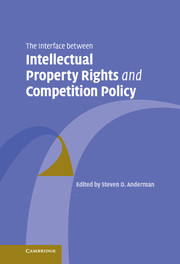Book contents
- Frontmatter
- Contents
- Notes on contributors
- Preface
- 1 The competition law/IP ‘interface’: an introductory note
- PART I Intellectual property rights and competition law in the major trading blocks
- 2 EC competition policy and IPRs
- 3 Competition policy and its implications for intellectual property rights in the United States
- 4 The interface between competition law and intellectual property in Japan
- PART II Intellectual property rights and competition law in smaller and medium sized open economies
- PART III Issues related to the interface between intellectual property rights and competition law
- Index
2 - EC competition policy and IPRs
Published online by Cambridge University Press: 27 July 2009
- Frontmatter
- Contents
- Notes on contributors
- Preface
- 1 The competition law/IP ‘interface’: an introductory note
- PART I Intellectual property rights and competition law in the major trading blocks
- 2 EC competition policy and IPRs
- 3 Competition policy and its implications for intellectual property rights in the United States
- 4 The interface between competition law and intellectual property in Japan
- PART II Intellectual property rights and competition law in smaller and medium sized open economies
- PART III Issues related to the interface between intellectual property rights and competition law
- Index
Summary
Introduction
EC competition policy and intellectual property rights (IPRs) are widely recognised to be complementary components of a modern industrial policy. Both pursue a common aim of improving innovation and consumer welfare although they do so by using rather different means. Intellectual property legislation such as patents, copyright and design rights laws pursue this aim by offering a period of exclusive rights to exploit to IP right holders as a reward and incentive to innovation and R&D investment. Modern competition policy attempts to keep markets innovative by maintaining effective competition on markets by preventing foreclosure of markets and maintaining access to markets. At first sight there seems to be a potential clash between the methods used by the two systems of legal regulation to achieve their common aims; the concern to maintain access to markets appears to be implacably opposed to the concept of exclusive rights to make, use and sell a product. And indeed, historically there was a period when the misunderstanding of the economic effects of IPRs led EC competition policy to attempt to place overly strict limits on the exercise of IP rights particularly in the field of patent licensing. Today, however, EC competition policy treats the economic effects of IPRs more realistically. It no longer assumes that the legal monopoly conferred by IP laws, such as patent and copyright legislation, to make and sell a particular product or process automatically amounts to an economic monopoly or even confers market power.
- Type
- Chapter
- Information
- Publisher: Cambridge University PressPrint publication year: 2007
- 6
- Cited by



